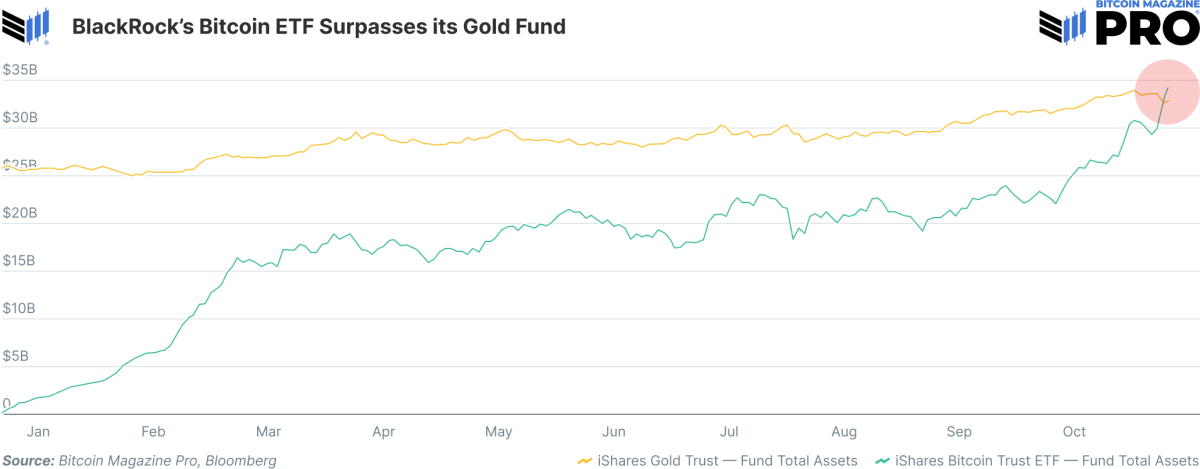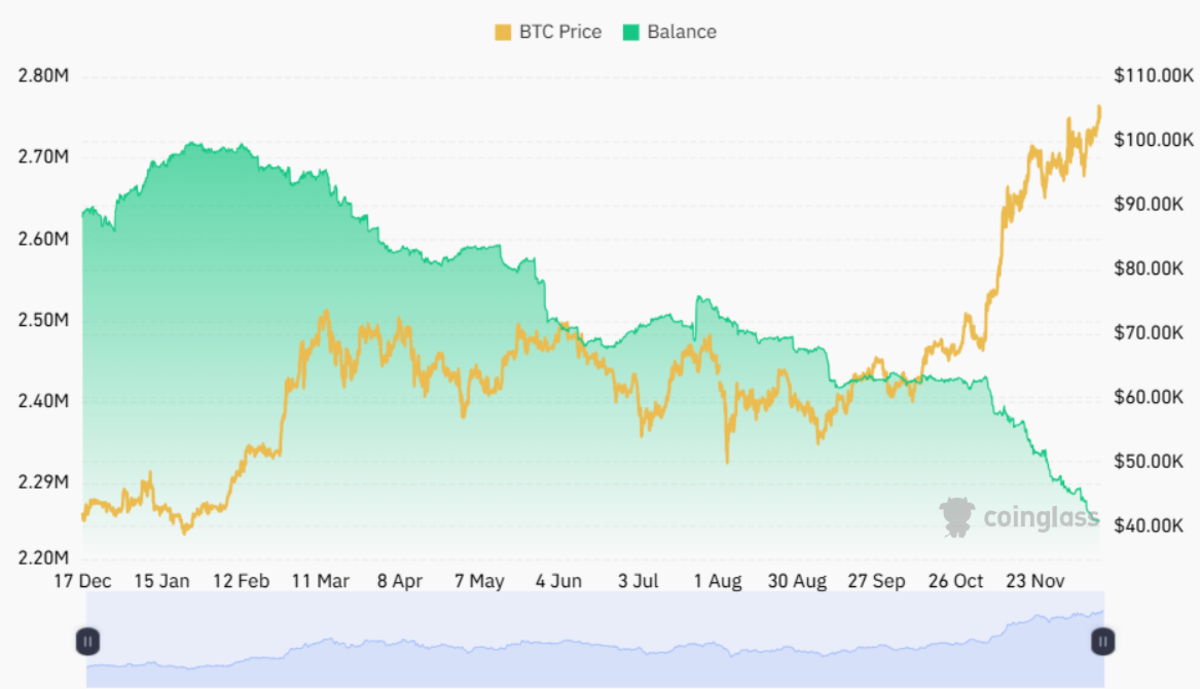As Bitcoin continues to mature, one of the most significant indicators of its longevity and integration into the broader financial ecosystem is the rapid growth of Bitcoin exchange-traded funds (ETFs). These products, which offer traditional, regulated exposure to Bitcoin, have garnered substantial inflows from both institutional and retail investors since their inception. According to data aggregated from Bitcoin Magazine Pro’s Bitcoin ETF Cumulative Flow Chart, Bitcoin ETFs have already accumulated more than 936,830 BTC, raising the question: Will these holdings exceed 1 million BTC before 2025?
THE #Bitcoin ETFs have already accumulated 936,830 #BTC! 🏦
Will it surpass one million BTC before 2025? 🪙
Let me know 👇 pic.twitter.com/UojJpJlC4P
— Bitcoin Magazine Pro (@BitcoinMagPro) December 16, 2024
The meaning of the value of 1 million BTC
Crossing the 1 million BTC threshold would be more than a symbolic milestone. This would indicate deep market maturity and long-term confidence in Bitcoin as a credible institutional-grade asset. Such a large amount of Bitcoin locked in ETFs effectively restricts supply on the open market, setting the stage for what could be a powerful catalyst for upward price pressure. As fewer coins remain available on exchanges, the market’s long-term balance shifts, potentially raising Bitcoin’s price floor and reducing downside volatility.
The trend is your friend: record inflows
The momentum is undeniable. November 2024 saw record inflows into Bitcoin ETFs, topping $6.562 billion, over $1 billion higher than the previous month’s figures. This wave of capital inflow dwarfs the rate of creation of new Bitcoin. In November alone, only 13,500 BTC were mined, while more than 75,000 BTC flowed into ETFs: 5.58 times the monthly supply. Such an imbalance underlines the scarcity dynamics currently at play. When demand far exceeds supply, the market’s natural response is upward pressure on prices.
A graph of insatiable demand
In a historic moment, BlackRock’s Bitcoin ETF recently surpassed the company’s iShares Gold Trust in terms of total fund assets. This moment was captured visually in the November issue of The Bitcoin Reportrevealing a clear shift in investor preferences. For decades, gold has sat atop the throne of “safe haven” assets. Today, Bitcoin’s emerging role as “digital gold” is validated by ever-growing institutional allocations. The appetite for Bitcoin-backed ETF products has become relentless, as both seasoned investors and new entrants recognize Bitcoin’s potential to serve as a cornerstone in diversified portfolios.

Long-term holding and supply shocks
A key feature of Bitcoin ETF inflows is the long-term nature of these investments. Institutional buyers and long-term allocators are less likely to trade frequently. Instead, they acquire Bitcoin through ETFs and hold it for extended periods: years, if not decades. As this pattern continues, Bitcoin held in ETFs is essentially removed from circulation. The result is a constant trickle of supply out of exchanges, pushing the market towards a potential supply shock.
This trend is clearly illustrated by the latest data from Coinglass. Just about 2.25 million BTC they currently remain on the exchange, highlighting a persistent decline in readily available supply. The chart below shows a divergence where Bitcoin price appreciation continues upward, while foreign exchange balances move downward – an irrefutable sign of scarcity dynamics at work.

A perfect Bitcoin bull storm and the march towards $1 million
These evolving dynamics have already pushed Bitcoin past the $100,000 mark, and such achievements may soon seem like distant memories. As the market rationalizes a potential journey to $1 million for BTC, what once seemed like an ambitious dream now appears increasingly achievable. The “multiplier effect” in market psychology and price modeling suggests that once a large buyer comes into play, ripple effects can cause explosive price spikes. With ETFs continually accumulating, each major purchase can trigger a cascade of subsequent purchases as investors fear missing out on the next step.
The Incoming Trump Administration, the Bitcoin Act, and a US Strategic Stockpile
If current trends weren’t bullish enough, a new and potentially transformative scenario is emerging on the geopolitical scene. President-elect Donald Trump in 2025 expressed support for the “Bitcoin Act,” a bill that would direct the Treasury to establish a strategic reserve of Bitcoin. The plan involves selling part of the US government’s gold reserves to acquire 1 million BTC, about 5% of all currently available Bitcoin, and holding it for 20 years. Such a move would mark a sea change in US monetary policy, placing Bitcoin on par with (or even ahead of) gold as the cornerstone of national wealth storage.
Given that ETFs are already causing shortages, a move by the US government to secure a large strategic reserve of Bitcoin would amplify these effects. Consider that only 2.25 million BTC are available on exchanges today. If the United States aimed to acquire nearly half of them in a relatively short time frame, the supply-demand imbalances would become extraordinary. This scenario could spark a hyperbullish mania, pushing the price of Bitcoin into previously unthinkable territory. At that point, even $1 million per BTC could be considered rational, a natural extension of the asset’s role in global finance and national strategic reserves.
Bottom line: a confluence of bullish forces
From short-term ETF inflows outpacing new issues by five times, to longer-term structural changes such as a potential Bitcoin reserve in the United States, fundamentals are lining up in Bitcoin’s favor. Increasing scarcity, combined with the multiplier effect of large buyers entering the market, sets the stage for exponential price appreciation. What was once considered unrealistic – a Bitcoin price of $1 million – is now within the realm of possibility, underlined by hard data and powerful economic forces at play.
The journey from today’s levels to a new era of Bitcoin price discovery involves much more than simple speculation. It is supported by shrinking supply, inflexible demand, growing institutional acceptance and even the potential imprimatur of the world’s largest economy. In this context, surpassing 1 million BTC in ETF holdings before 2025 could be just the beginning of a much larger story, one that could reshape global finance and reimagine the very concept of reserve assets.
For the latest insights into Bitcoin ETF data, monthly inflows and evolving market dynamics, explore Bitcoin Magazine Pro.
Disclaimer: This article is for informational purposes only and should not be considered financial advice. Always do your research before making any investment decisions.
